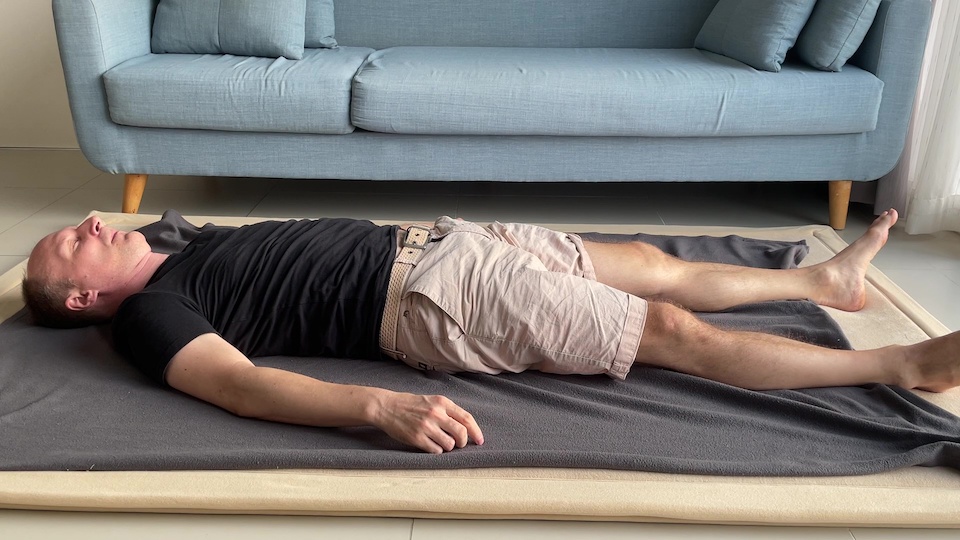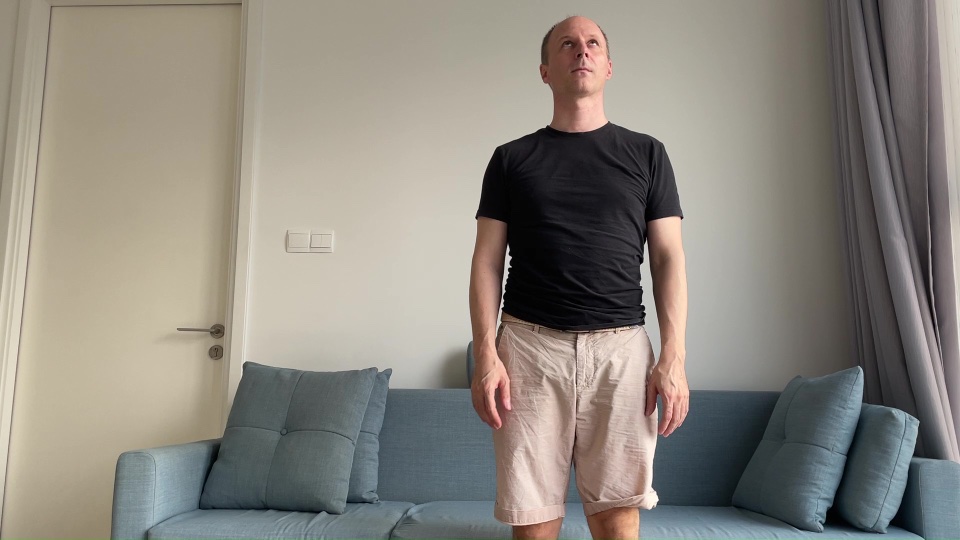Circles of the knee in prone position
You start with a simple movement: bend your knee in prone position (on the belly), then you explore how you can hold your foot with one or both hands behind your back. Then you try to lift your knee while holding your foot behind your back—an extension movement. Then you review movements of the ankle. Still in prone position, you hold your ankle with one hand and tilt your lower leg left and right. After that you explore moving your knee along the floor to the left and to the right until you move your knee is moving in full circles, sandwiched in between your torso and the floor.
You will move your hip joint from extreme extension to extreme flexion, from extreme adduction to extreme abduction in a functional progression. This will improve your leg's integration in your whole body's movement patterns, and also your movement organization, awareness and range of motion of your legs: how you position and move each leg, including its hip joint, knee and ankle in relation to each other, and in relation to your torso, shoulder girdle and head. You explore how even small movements of the ankles can be integrated in a full body movement. In a larger picture this will have positive influence on your lower back, back extension, your standing upright, sitting, and walking.
heels-under-pelviship-jointsanklesflexionextensioncrawlingUP4prone circles_with_the_legs_1
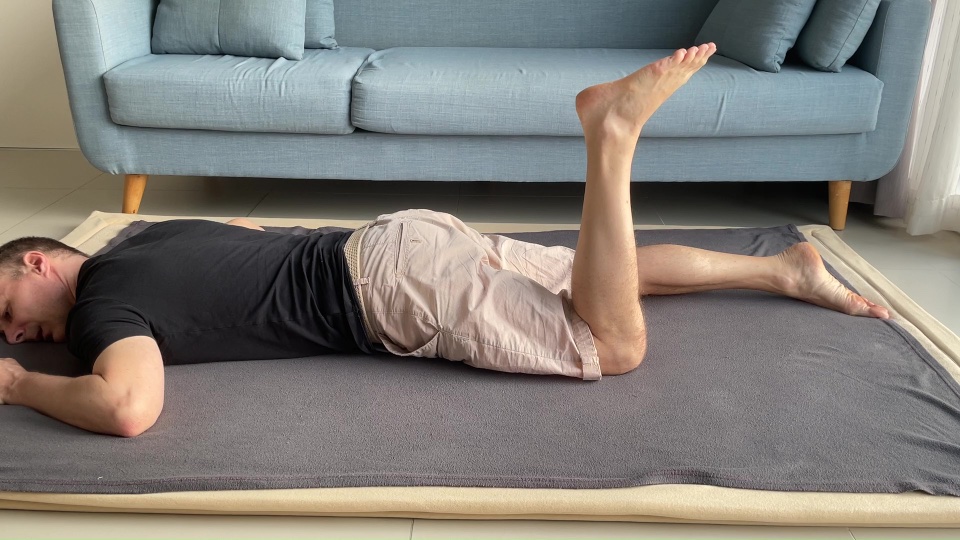
Lie on your belly, with your head and arms in a comfortable position.
Bend left knee
Bend your left knee, how well does it bend?
- Leave your knee where it is, only bend your knee, so that your foot comes closer to the ceiling.
When does the movement start to feel thick, and the lower leg tend to spring back towards extension?
Bend left knee
Bend your left knee, how well does it bend?
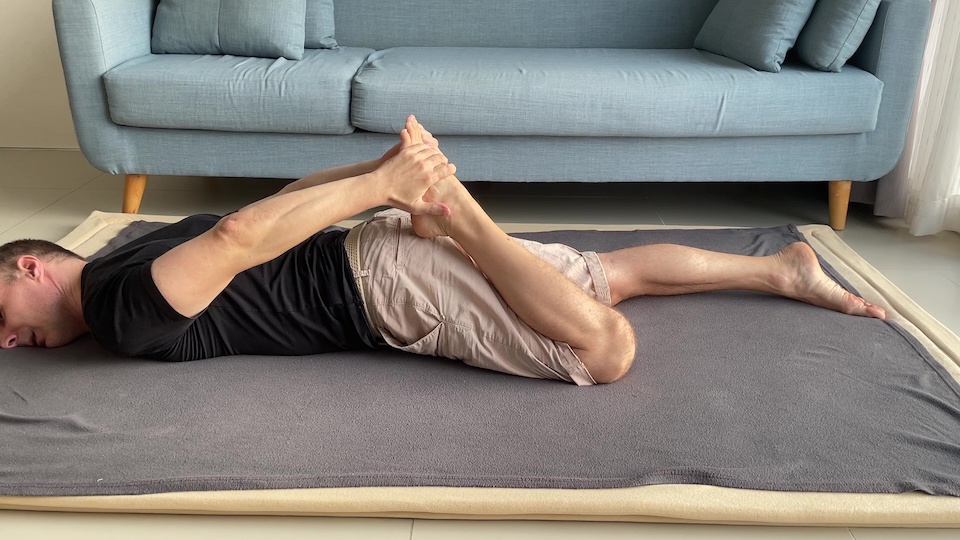
Rest in prone position like before, hold your left foot with both hands.
Hold your left foot
Bend your left knee, get hold of your foot with both hands. How and how well does it work?
- Try to hold your left foot with either the left hand, or the right hand, or both hands, in various hand positions, for example hold one toe, several toes, hold the ankle, the heel etc.
Hold your left foot
Bend your left knee, get hold of your foot with both hands. How and how well does it work?
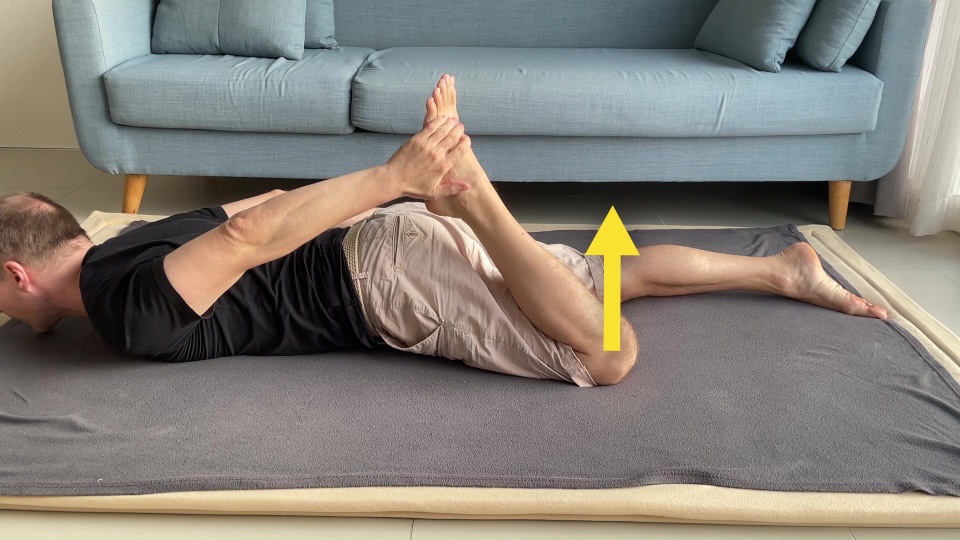
Rest in prone position like before, hold your left foot with both hands.
Lift left knee
Hold your left foot with both hands and lift your left knee.
- Is it easier when you also lift your head?
Be gentle with yourself, do not strain your knee, try to lift your knee gradually, take a rest early on.
Lift left knee
Hold your left foot with both hands and lift your left knee.
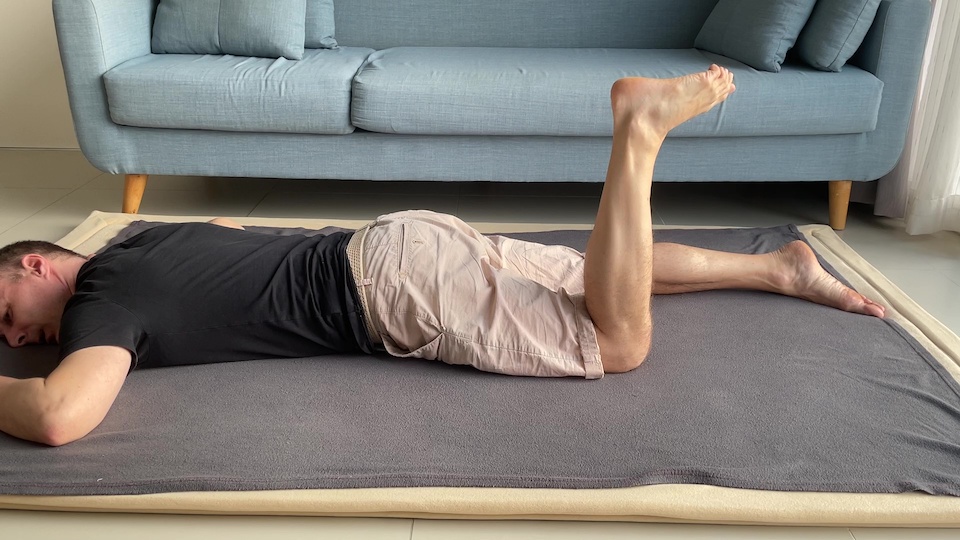
Rest in prone position like before, left knee bent, your hands and head in a comfortable position.
Left ankle left-right
Tilt your left your ankle as if to lean against the outside or inside edge, if you were standing.
- This movement is not a rotation of your lower leg, but a bending of your left ankle left and right, as if you would tilt your foot to lean against it's outside or inside edge, alternately.
Left ankle left-right
Tilt your left your ankle as if to lean against the outside or inside edge, if you were standing.
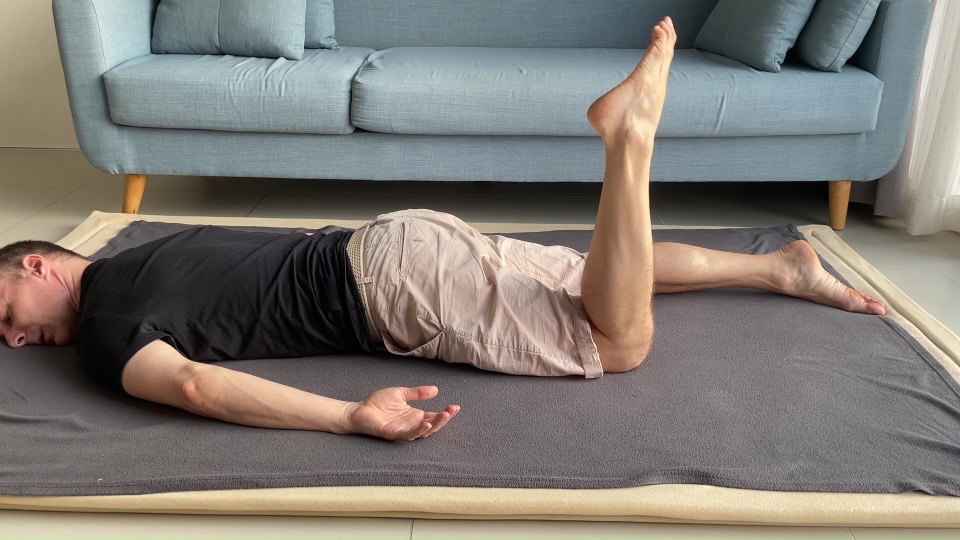
Rest in prone position like before, left knee bent, your hands and head in a comfortable position.
Continuation
Left ankle flexion
Bend and extend your left ankle, to bring your toes closer and further away from your shinbone.
- Go from dorsi-flexion to plantar-flexion.
Also keep your whole foot in mind: in which direction does your heel move when you move your forefoot?
Continuation
Left ankle flexion
Bend and extend your left ankle, to bring your toes closer and further away from your shinbone.
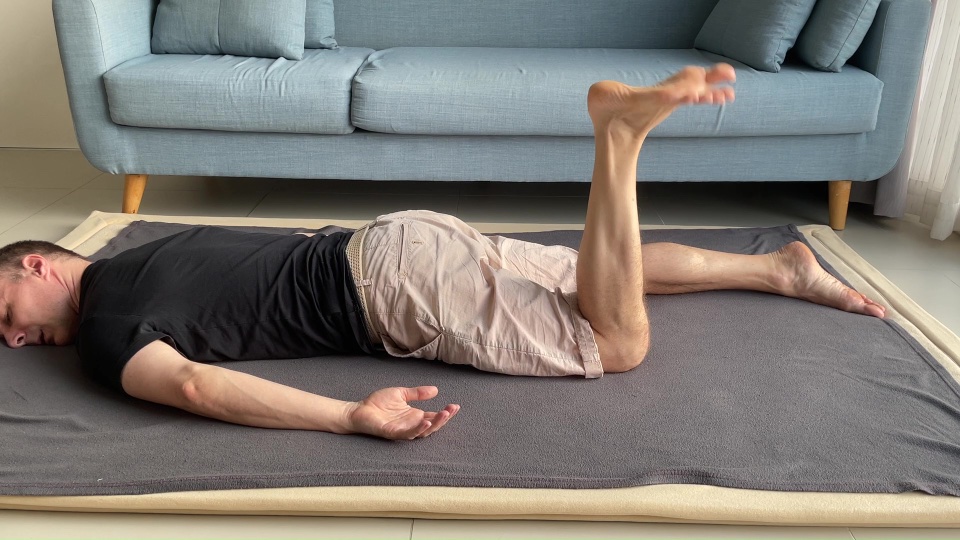
Rest in prone position like before, left knee bent, your hands and head in a comfortable position.
Continuation
Left ankle circles
Combine the previous to movements to draw circles with your foot.
- Clockwise, counterclockwise, small, big, fast, slow.
Try to smoothen out rough edges of the circle and to get good control over your ankle movements.
Continuation
Left ankle circles
Combine the previous to movements to draw circles with your foot.
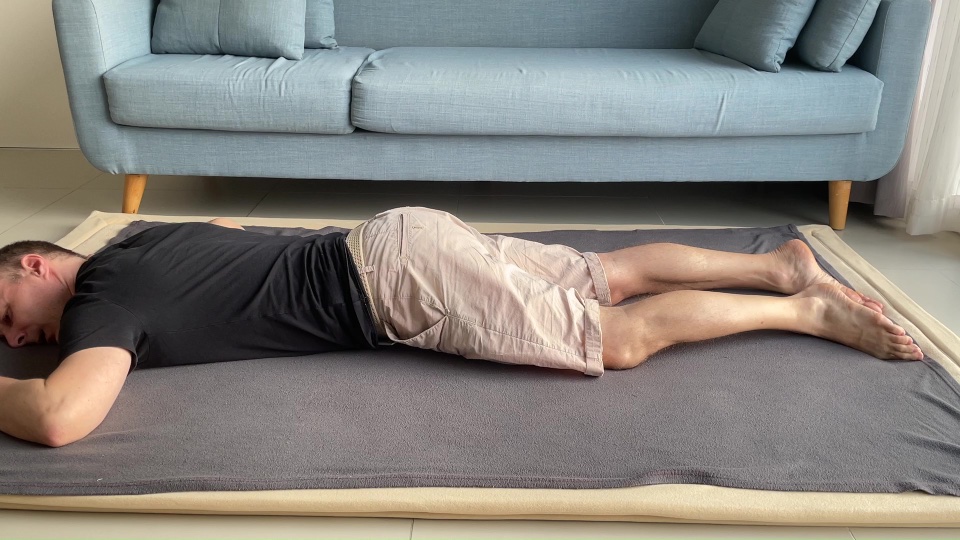
Rest in prone position like before, left leg extended, your hands and head in a comfortable position.
Roll left leg
Roll your left leg on the floor, for your heel to come closer to the floor on the left and right side alternately.
- Roll your leg but also tilt your heel.
Keep your leg in the same place, do not drag the whole leg left and right.
Allow all the bones in your left foot to move, slightly twist, do whatever feels comfortable and necessary to tilt your heel once to the left, once to the right side.
Roll left leg
Roll your left leg on the floor, for your heel to come closer to the floor on the left and right side alternately.
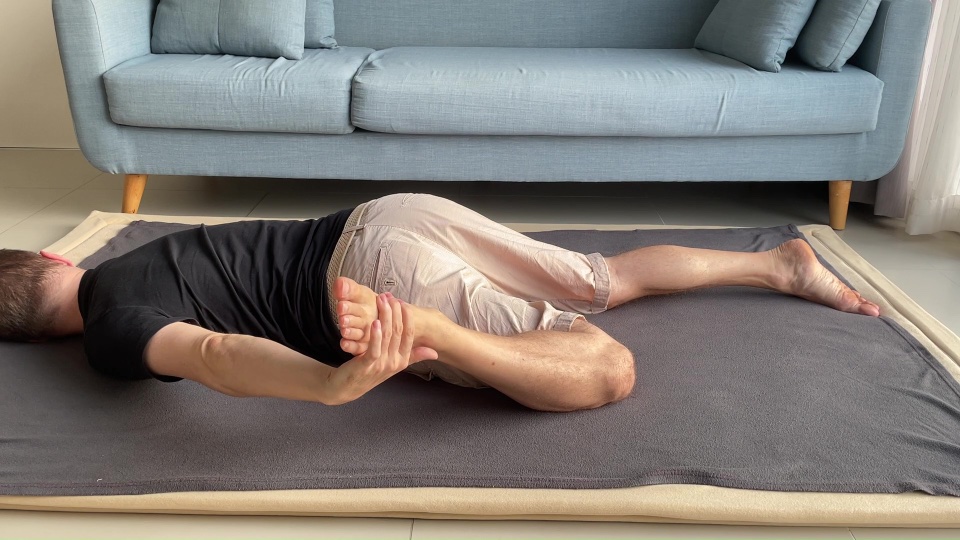
Rest in prone position like before, right leg extended, left knee bent, hold your left foot in either your left or right hand.
Tilt lower leg left/right
Tilt your lower leg to bring your left foot closer to the floor to each side. Change over your hands.
- Keep your knee in place, don't drag your knee to the left or right.
When you tilt your lower leg to the right, hold your left foot with your right hand, and vice versa.
Allow your whole body and head to move and roll and twist as it's comfortable and necessary.
Tilt lower leg left/right
Tilt your lower leg to bring your left foot closer to the floor to each side. Change over your hands.
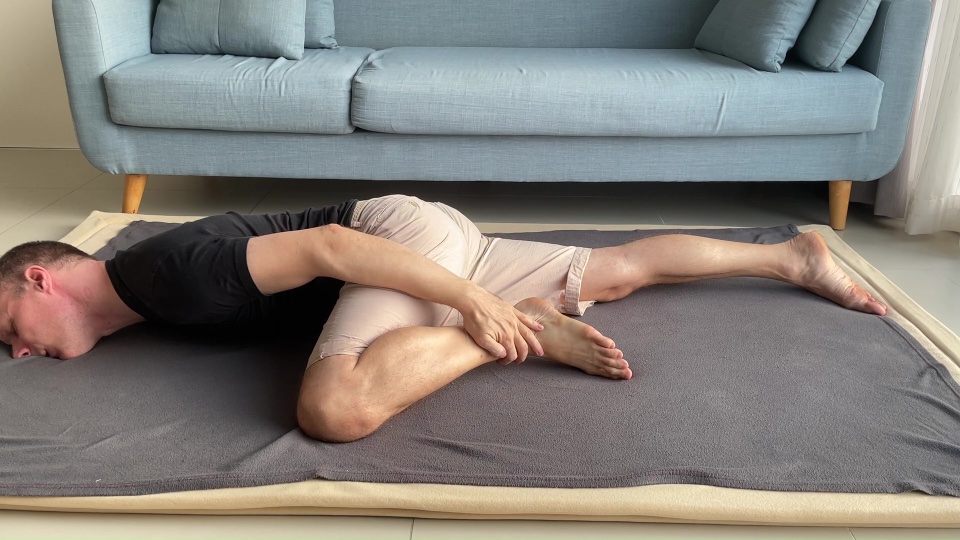
Rest in prone position like before, left knee bent, hold your left foot at its ankle with your left hand.
Bend left knee to the left
Bend your leg to slide your knee to the left on the floor.
- Keep holding your left ankle with your left hand.
Roll your pelvis as much as it is necessary and comfortable. Move slowly and keep breathing freely.
Bend left knee to the left
Bend your leg to slide your knee to the left on the floor.
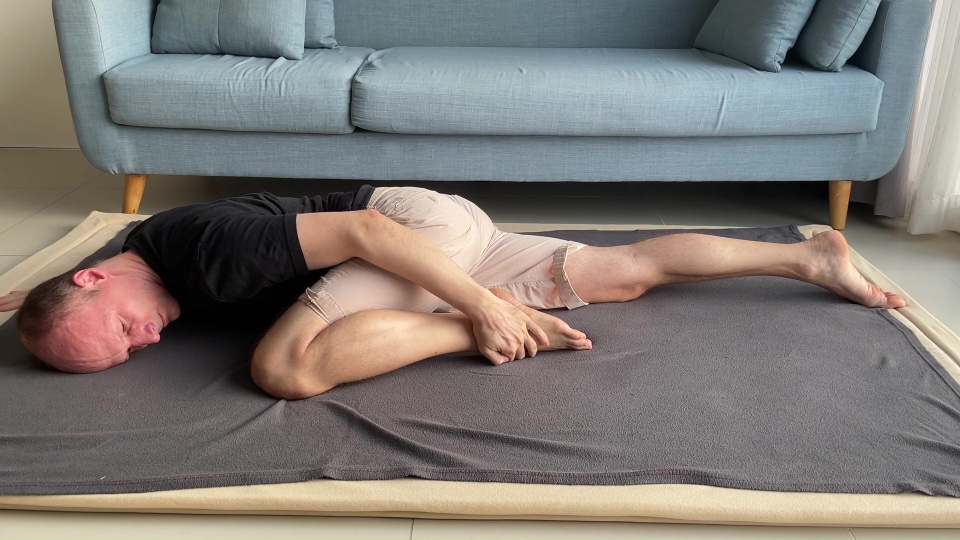
Rest in prone position like before, left knee bent to the left on the floor, hold your left foot at its ankle with your left hand. Stand your right hand on the floor near your right shoulder.
Knee in 4 directions
Towards your left side move your left knee up towards your head, then down, then forwards and backwards.
- Keep holding your left ankle with your left hand. Help by pushing the floor with your right hand.
Roll your pelvis as much as it is necessary and comfortable. Move slowly and keep breathing freely.
Knee in 4 directions
Towards your left side move your left knee up towards your head, then down, then forwards and backwards.
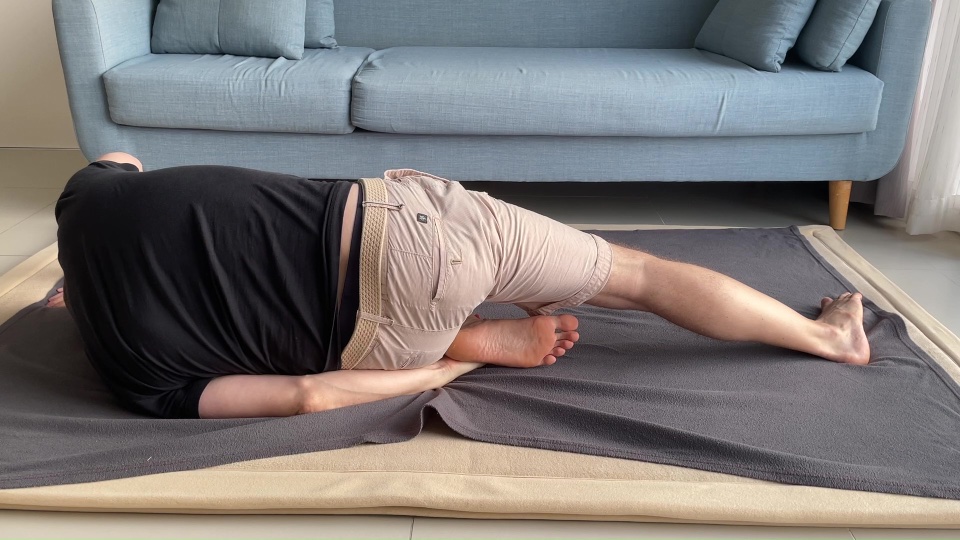
Rest in prone position like before, left knee bent, hold your left foot at its ankle with your left hand.
Bend left knee to the right
Draw your left knee on the floor to the right, allow your pelvis to turn to the right.
- Keep holding your left ankle with your left hand.
Roll your pelvis as much as it is necessary and comfortable. Move slowly and keep breathing freely.
Bend left knee to the right
Draw your left knee on the floor to the right, allow your pelvis to turn to the right.

Rest in prone position like before, left knee bent to the left on the floor, hold your left foot at its ankle with your left hand. Stand your right hand on the floor near your right shoulder.
Knee in 4 directions
Towards your right side move your left knee up towards your head, then down, then forwards and then also backwards.
- Keep holding your left ankle with your left hand. Help by pushing the floor with your right hand.
Roll your pelvis as much as it is necessary and comfortable. Move slowly and keep breathing freely.
Knee in 4 directions
Towards your right side move your left knee up towards your head, then down, then forwards and then also backwards.

Rest in prone position like before, left knee bent, hold your left foot at its ankle with your left hand.
Bend left knee to the left/right
Bend your leg to slide your knee to the left and right on the floor.
- Keep holding your left ankle with your left hand.
Draw up your knee towards your face on your left side, and then turn your head to do the same towards the right side.
Roll your pelvis as much as it is necessary and comfortable. Move slowly and keep breathing freely.
Bend left knee to the left/right
Bend your leg to slide your knee to the left and right on the floor.
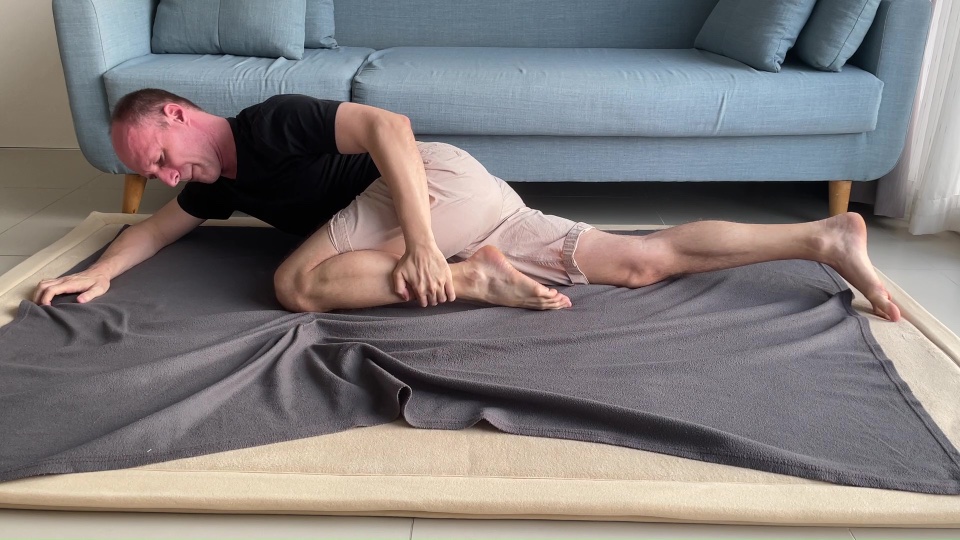
Rest in prone position like before, left knee bent, hold your left foot at its ankle with your left hand. Stand your right hand on the floor near your right shoulder.
Continuation
Knee circles
Continue and connect the previous movements until your knee is drawing large circles.
- Stay in prone position, but move as much as it is necessary to make circles with your leg.
You pass your leg in front of your torso by bending your knee, and then extend your leg downwards again.
Clockwise, counterclockwise, small, big, fast, slow.
Continuation
Knee circles
Continue and connect the previous movements until your knee is drawing large circles.

Rest in prone position like before, hold your left foot with both hands.
Reference movement
Compare
For example hold your foot and lift your knee. Did it improve?
- You can take any movement of this lesson as a reference movement.
For example: we often switched between flexion and extension of the hip joint – how did this improve your overall extension in the knee-lift test?
In which ways did it change? Are you more aware of what is going on in this movement? Is it easier? Where and how is it easier?
Reference movement
Compare
For example hold your foot and lift your knee. Did it improve?

